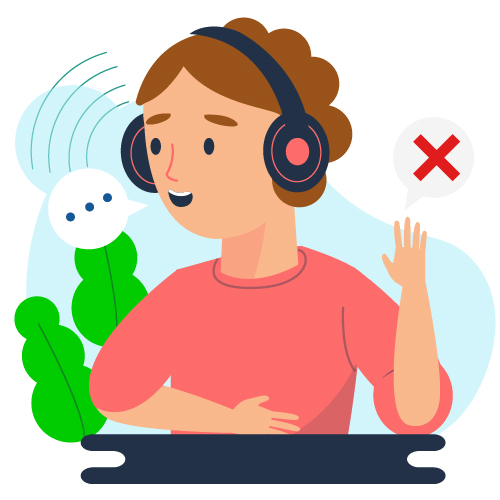
listening tips for IELTS Exam
Listening tips for IELTS are partitioned into listening test explicit abilities/tips and, afterwards, broad English language listening abilities. Many understudies centre around the IELTS test abilities and fail to remember that language ability will generally precede test abilities.
Test Skills
14 Listening tips for your IELTS test, Listening test structure.
Monitor your outcomes and improvement, IELTS composing and listening simultaneously.
Five stage technique for further developing your listening abilities for IELTS:
Language Skills
Listening Resources (genuine local English speaker material)
Instructions to further develop your listening abilities
Instructions to grasp local English speakers
For what reason do local speakers sound like a square of sound!
14 Listening tips for your IELTS test
Endeavour all inquiries – there are no punishments for erroneous responses. Be mindful not to squander life on an inquiry that you don’t have any idea; however, surmise and continue.
Look out for plurals in replies. Assuming the inquiry requires a plural response, a solitary response is erroneous.
Answers show up in the request. They are heard in the sound. They come rapidly or with huge holes between them.
Get ready to hear a potential response that isn’t genuine. For example, it is normal when two individuals are making arrangements. They initially settled on gathering at a specific time; however, one recollects that they can’t, so they settle on another time.
Take care when you move your responses and focus as far as possible on your responses on your response sheet!
Numerous decision answers will request a letter (a, b, c, d). Compose the letter and not the relating reply.
When requested to finish a sentence utilizing something like two words, and the correct response is “cowhide coat,” then, at that point “, a coat made of calfskin” is mistaken. The same goes for numbers.
Joined words (like “part-time”) are considered a single word.
A date (1990) is viewed as one number.
Zero in on what the speaker is talking about, not how they say it.
Try not to take notes in complete sentences – write down the central issues and condense. Of course, you have to record to aid your memory later.
Get the propensity for recognizing fundamental and unnecessary data. For example, if two individuals are looking at making arrangements for a supper date, the critical data is the date/time they, at last, concur upon. Different dates/times they considered become insignificant.
Attempt to think about the thing the speaker will say. Speakers will frequently drop hint words or frameworks to discuss ahead of time. It empowers you to begin your blueprint to fill in then.
Stand by listening to the IELTS web recording, take notes and further develop your note-taking abilities.
IELTS listening tips to foresee replies in the listening test
You have the fantastic chance to peruse the inquiries before paying attention to the recording. Exploit this!
The inquiries can assist you with figuring out what kind of answer you’re searching for. For instance, if you have the accompanying inquiry:
“He might want to meet in ____________.”
The relational word “in” hints you into the sort of answer you ought to search for.
The response for this situation must be either a timeframe (2 days), a month (April), a year (2018), or a season (Winter).
Various relational words will direct various responses.
Here are a few models:
Relational word: AT
Conceivable response: Time, Part of Day, Place
Models: 9 pm, sunrise, the café
Relational word: IN
Conceivable response: Period, Month, Year, Season
Models: 2 days/hour/minutes, April, 2018, Winter
Relational word: ON
Conceivable response: Day, Date
Models: Monday, January fifteenth (or January fifteenth)
Relational word: no relational word
Conceivable response: Person other
Models: Emily now, on the double, tomorrow, one year from now, this evening, individual
What occurs on the listening test?
The IELTS listening test is intended to survey how well you can:
- Grasp both primary thoughts and definite data
- Perceive the suppositions and perspectives of a speaker
- Follow the advancement of thought or contention
IELTS listening test structure
- The listening test is no different for IELTS scholastic and IELTS general preparation, and they are scored similarly.
- You will pay attention to four unique accounts and afterwards answer 10 composed inquiries for every (40 altogether)
- You will hear each recording once.
- You have 40 minutes for each of the four areas. Thirty minutes to pay attention to the accounts and compose your responses on the inquiry paper. Then, 10 minutes to move these to the response sheet at that point.
The accounts and questions get more troublesome as the test advances:
- Segment 1 is two speakers having a regular discussion. They may be making arrangements for the end of the week or examining where to eat that evening.
- Area 2 is a discourse (one individual discussing) about an ordinary circumstance. For example, it might be a discourse or a discussion about making arrangements for something.
- Area 3 is a scholarly discussion between up to 4 individuals.
- Segment 4 is a discourse on a scholarly theme.
- The accounts incorporate a scope of accents, most likely British and Australian, so attempt to get to know these. However, we can hear an inspector for the talking segment in this recording with a Scottish articulation.
You can observe more information about the listening test on the IELTS site.
Sound overpowering? Try not to stretch. We will break down the fundamental abilities expected to score well on this segment test and blueprint a few hints for you.
Monitor your outcomes and improvement
For the perusing and tuning in, take practice tests to see where you’re losing focus. Practice tests are incredible because they will show what areas of English are offering you inconvenience and where to concentrate your consideration to move along.
Zero in on your points of weakness at first before spreading out toward another path! IELTS composing and listening at the same time (essential expertise!) Composing while at the same time listening is demanding on the off chance that you expect to catch everything.
The key here is that it’s not generally imaginable throughout the whole test, so don’t allow this strategy to occupy an excessive amount of time. It will expect you to foster your focus abilities and breaking point interruptions considerably more so than before because you are presently utilizing both of these abilities simultaneously. Pick apart the perusing and listening tests. We likewise notice this tip in the IELTS Preparation guide.
Track down accurate IELTS tests. Cambridge is the best since they are usually more enthusiastic than the genuine test. Ensure you have the response key. Specific individuals sell it independently. The Cambridge practice tests are additionally composed by similar experts who compose the authority tests. Plunk down with a test paper, look at the responses first, and check the inquiries afterwards.
Work out how the inquiries are posed, what they ask and how.
This methodology for the IELTS listening test makes it far simpler to find answers when you do the genuine test.
Our IELTS Reading on the web arrangement course is for individuals who need to score high on the test the first time. It has video illustrations of the most proficient method to respond to every particular inquiry style. Interface It is only one of the courses we propose to help you improve and get ready.
How can the IELTS listening score determine?
The IELTS listening test tests English perception abilities. The analyst hopes to see whether you can pay attention to a snippet of data and effectively answer questions.
The listening scores are out of 40 and are determined based on the number of correct responses. Focuses are not removed for mistaken replies. Whenever you have finished the listening test, you will be reviewed by the simultaneous data transmission going from a score of 4 to 9.
Five stage technique for further developing your listening abilities for IELTS Further developing your listening abilities requires dynamic (not uninvolved) listening practice. Zeroing in on understanding what you are paying attention to is significant when you work on tuning in.
The best strategy to foster this expertise is consolidating, tuning in and perusing. Track down sound models with a text record to look at your appreciation in the wake of tuning in.
Stage 1: Listen to the brief snippet (no perusing)
Perceive the amount you can comprehend the overall essence and begin to select watchwords.
Stage 2: Endlessly rehash (still no perusing!)
Pay attention to the clasp once more. Given what you grasped the initial time, is there more than you can select?
Keep on paying attention to the clasp a few times to check whether you can fathom somewhat more each time.
You could move to stage 3 when you do not appreciate much else from the sound. Your objective ought to be to comprehend as much as expected from the sound!
Stage 3: Read the text
Take a look at your comprehension and distinguish any new jargon. Check whether you can determine the importance of any new words given the setting before finding them.
Stage 4: Listen to the text
Pay attention to the way to express expressions and gatherings of words.
Stage 5: Listen to a couple of additional times without the text
Now, you ought to have the option to grasp most of the clasp. Reiteration makes the words and expressions more obvious when you hear them once more.



